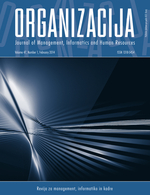The Impact of Demographic Changes on the Organization of Emergency Medical Services – The Case of Slovenia
Abstract
Background and Purpose: The modern environment requires that organizations (profit and non-profit) continually harmonize their organizational models with changes in their respective environments and with their own visions and strategies for further development. The organizational structure of Emergency Medical Services (hereinafter EMS) is currently a very topical issue in Slovenia, given that a project to establish a new organization of EMS is currently underway at the national level. By examining the case of one region in Slovenia, this article presents an analysis of factors that impact on the number and types of EMS activities and depicts a forecast of future trends for the requirement of EMS. The analysis presents the initial phase of a strategic planning process for the mentioned activity and consequently, a starting point for the formation of an organizational EMS model.
Methodology: This article presents an analysis of factors that impact on the formulation of an EMS model on the basis of research carried out for one geographical region of Slovenia. For the previous period, data was collected from 2002 to 2014. The software tool used for the analysis was STATA 13.0. For the purpose of forecasting a five-year period trend we used statistical package RStudio and Hyndman´s Forecast package given that this package contains algorithms for forecasting univariate time series including exponential smoothing using automated spatial models and ARIMA modelling.
Results: The research has confirmed a correlation between social/environmental factors and the rate of increase in the demand for EMS. A population´s age structure has been identified as the key social factor that increases the need for EMS. On the basis of this finding, this article presents a model for forecasting growth trends in the scope of EMS activities.
Conclusion: The research study has identified some important elements that are imperative to take into consideration when formulating an EMS network at the prehospital level. Population ageing has emerged as a key social factor. In the accordance with forecasted trends, an increase in the burden placed on EMS activities may also be anticipated in the future.
Methodology: This article presents an analysis of factors that impact on the formulation of an EMS model on the basis of research carried out for one geographical region of Slovenia. For the previous period, data was collected from 2002 to 2014. The software tool used for the analysis was STATA 13.0. For the purpose of forecasting a five-year period trend we used statistical package RStudio and Hyndman´s Forecast package given that this package contains algorithms for forecasting univariate time series including exponential smoothing using automated spatial models and ARIMA modelling.
Results: The research has confirmed a correlation between social/environmental factors and the rate of increase in the demand for EMS. A population´s age structure has been identified as the key social factor that increases the need for EMS. On the basis of this finding, this article presents a model for forecasting growth trends in the scope of EMS activities.
Conclusion: The research study has identified some important elements that are imperative to take into consideration when formulating an EMS network at the prehospital level. Population ageing has emerged as a key social factor. In the accordance with forecasted trends, an increase in the burden placed on EMS activities may also be anticipated in the future.
Refbacks
- There are currently no refbacks.

